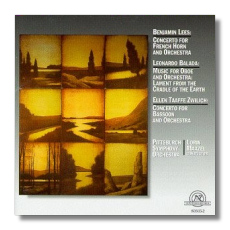
The Internet's Premier Classical Music Source
Related Links
- Latest Reviews
- More Reviews
-
By Composer
-
Collections
DVD & Blu-ray
Books
Concert Reviews
Articles/Interviews
Software
Audio
Search Amazon
Recommended Links
Site News
 CD Review
CD Review
Lorin Maazel

Contemporary American Concertos
- Benjamin Lees: Concerto for French Horn & Orchestra
- Leonardo Balada: Music for Oboe & Orchestra "Lament from the Cradle of the Earth"
- Ellen Zwilich: Concerto for Bassoon & Orchestra
William Caballero, French horn
Cynthia Koledo DeAlmeida, oboe
Nancy Goeres, bassoon
Pittsburgh Symphony Orchestra/Lorin Maazel
New World Records 80503-2 62:04
Summary for the Busy Executive: Handsome accounts, and at least somebody knows what he's doing.
Strictly speaking, these are all "contemporary" concerti, in the sense that the composers are still alive, but stylistically they wander all over the map. The Lees concerto resembles neoclassic American Modernism, Balada neo-Romanticism, and Zwilich the international postwar style.
I might as well begin with the music that engages me least. Ellen Zwilich has had a great career, so obviously somebody likes her stuff. I myself find very little that hooks me. The bassoon concerto, I must say, I like best of the pieces I've heard, probably because it reminds me, rhythmically and harmonically, of Bernstein. The work brims full with expertise. The bassoon writing seems both virtuosic and suited to the instrument. However, I don't find that it adds up to all that much, other than a better-than-average response to a commission. Like most of the pieces in Zwilich's catalogue, I don't really understand why she had to write it.
Leonardo Balada teaches at Carnegie-Mellon and has received a number of nice commissions. Those who go on about the stylistic hegemony of the academy should take a listen to his work, which has very little to do with Boulez, Nono, Berio, Babbitt, or Stockhausen. Indeed, it has very little to do with Schoenberg and Webern. Eminently tonal, maximal rather than minimal, it has more in common with Barber and Menotti. The concerto's subtitle, of course, should tip you off as to Balada's Romantic sensibility. Balada, like Tchaikovsky, has a penchant for combining basic ideas in such a way that they sound like songs, which gives his music, I think, a leg up with most listeners, and of course such a habit suits the oboe down to the ground. Nevertheless, "Romantic" doesn't mean the same thing as "good." The piece calls to mind an updated Also sprach Zarathustra, with crescendo boffo opening, Dance of Joy, etc. Like the Strauss, it also goes on way too long for its material, with no genius vulgar sections to goose interest along the way. Any moment now, I keep thinking, it will burst into something wonderful, but that moment never arrives. The piece comes across as a very long transition to nothing, with expanded percussion.
Lees has a demonstrated affinity for the concerto form. He's written not only at least one concerto for the usual suspects, but also "sectional" concertos for first-desk strings, winds, and brass. His music is full of dramatic contrast anyway, which translates well to the genre. It's not merely a matter of dynamic or scoring contrasts. The musical ideas themselves have distinct characters. In the horn concerto's first movement, for example, the opening idea resembles a fanfare, and the notes jump around largely on skips of fourths and fifths. The second major idea, however, keeps hitting two notes a second apart. These cells provide most of the movement's argument. Just as impressive, the character of the movement (marked "boldly") never flags through its eight-minute run.
The second movement begins with the horn singing all by itself, anchored in a fundamental note and flowering from there. A lyrical mood predominates, while the music avoids sentimentality and predictability. The music intensifies, becoming quite gruff, even nervous, in places. Three themes – the opening song, a theme built on successive thirds, and one that stutters repeated notes – not only keep interest, but also clarify the musical argument. New themes grow out of new combinations – for example, parts of the opening song combined with the stuttering rhythm. Lees's ability to find power in very basic ideas never fails to amaze me. The movement ends as it began, with the solo horn, although it's not, as you might expect, an arch structure. Lees neatly avoids that particular cliché.
The finale is a triple-time motor that gets the body moving, not least because of artful syncopation and, of course, Lees's absolute mastery of symphonic rhetoric. The end exhorts the audience to rise and cheer. Here's one composer who knows exactly what he wants and how to get it, all in his own way. Although in many ways Lees is the most stylistically conservative of the trio, his music doesn't really remind you of anybody else. He studied with Halsey Stevens and George Antheil, two strong artistic personalities, and managed to avoid sounding like either. Independence was probably the main lesson he learned from both.
The Pittsburgh Symphony has quietly made great music at least since the Fritz Reiner days. The only reason I can see for its low profile is that it never had a good record deal and it lived in Pittsburgh. Maazel gives wonderful support to terrific soloists, all of whom meet the considerable technical challenges and all of whom wring as much music as can be had from these works. The composers should all write thank-you notes, if they haven't already.
Copyright © 2003, Steve Schwartz


















